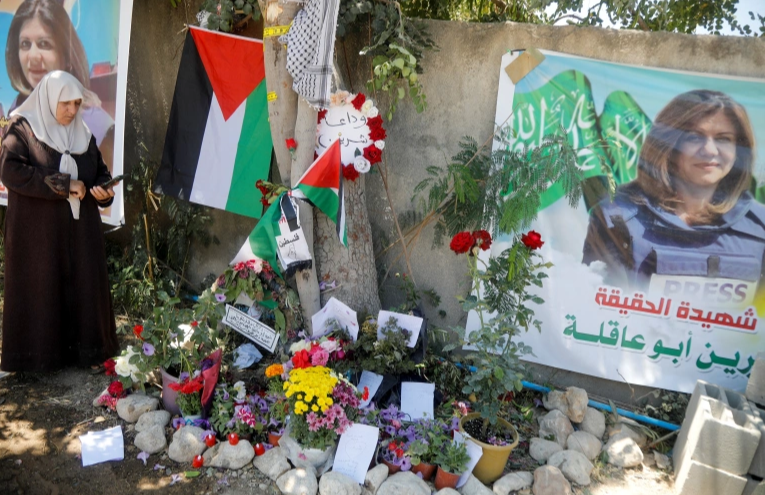
New York Times report concludes that the bullet that killed Abu Akleh came from the 'approximate location' of an Israeli military convoy [File: Al Jazeera]
New York, June 22 (RHC)-- A New York Times investigation has concluded that an Israeli soldier “most likely” fatally shot Al Jazeera journalist Shireen Abu Akleh, adding to a growing body of independent probes that have found that the Palestinian-American correspondent was killed by Israeli forces.
The New York Times report, published on Monday, said no Palestinian armed men were near Abu Akleh at the time she was killed in the occupied West Bank, dismissing early Israeli theories blaming Palestinians for the incident.
The probe relied on available video footage, witness testimonies and an acoustic analysis of the bullets fired around the time Abu Akleh was killed. “A month-long investigation by The New York Times found that the bullet that killed Ms. Abu Akleh was fired from the approximate location of the Israeli military convoy, most likely by a soldier from an elite unit,” the report reads.
The killing of Abu Akleh on May 11 sparked international outrage and calls for accountability for attacks on journalists. The slain journalist covered events and Israeli attacks in the occupied Palestinian territory for 25 years, becoming a familiar face across the Arab world.
She was killed while in full protective press gear clearly identifying her as a journalist, as she prepared to cover an Israeli raid in the West Bank city of Jenin.
Reports by the Washington Post, the Associated Press and the investigative group Bellingcat have previously concluded that Israeli forces likely killed Abu Akleh. A CNN investigation last month said evidence suggests that the veteran journalist was killed in a “targeted attack by Israeli forces”.
A probe by the Palestinian Authority also found that Abu Akleh was deliberately shot by Israeli forces. Last week, Al Jazeera obtained an image of the bullet that killed Abu Akleh, which was extracted from her head. According to ballistic and forensic experts, the bullet was designed to pierce armour and is used in M4 rifles, which are carried by the Israeli army. The round was manufactured in the United States, experts said.
Al Jazeera Media Network has accused Israeli forces of assassinating the journalist "in cold blood." Israel, which has repeatedly changed its story about how Abu Akleh was killed and its stance on the investigation, has rejected such reports.
Late in May, Israeli foreign minister Yair Lapid said he expressed his “protest” to his U.S. counterpart Antony Blinken over what he called “biased investigation of [Abu Akleh’s] death by the Palestinian Authority as well as the so-called ‘investigation’ by CNN.”
Blinken and other officials from the President Joe Biden’s administration have urged a transparent probe into the killing of Abu Akleh while insisting that Israel is the authority to conduct such an investigation. Washington also rejected the possible involvement of the International Criminal Court in the case.
Palestinian rights advocates have been denouncing the U.S. position, stressing that Israel cannot be trusted to investigate itself. “Palestinian deaths rarely attract international scrutiny, and soldiers accused of crimes against Palestinians in the West Bank are rarely convicted,” the New York Times’ report said on Monday.
Despite investigations and available evidence pointing the finger at Israel, Blinken said earlier this month that the facts in Abu Akleh’s killing “have not yet been established.”
In the same remarks, the top U.S. diplomat called for an “independent” investigation, but the State Department later told Al Jazeera that there “has been no change” in the U.S. approach – that Israel should be the party conducting the probe.
After the killing of Abu Akleh, Israeli forces attacked mourners at her funeral, nearly forcing pallbearers to drop the slain journalist’s coffin.
Israel initially said “it appears likely that armed Palestinians” were responsible for killing Abu Akleh. After the incident, the office of Prime Minister Naftali Bennett shared a video of Palestinian gunmen firing into an alleyway, suggesting that they were the ones who shot Abu Akleh. But the theory was quickly debunked as armed men had no line of sight to the slain journalist who was killed hundreds of metres away. And the video was taken hours before the correspondent was killed.
Days later, the Israeli army acknowledged that the journalist might have been killed by Israeli fire, but excluded the possibility that she may have been shot deliberately.
Israeli authorities have also changed their position on the investigation. While Israel requested access to the bullet that killed the journalist, early on it said there would be no criminal review into the incident.
But Israeli media outlets later cited the Israeli army’s top lawyer as saying that the military is “making every effort” to investigate the incident. Earlier this month, however, the Washington Post cited the Israeli army as saying that it “had already concluded that there was no criminal conduct” in the killing of Abu Akleh.

